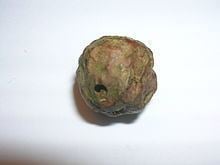Family Cynipidae | Genus Andricus Rank Species | |
 | ||
Similar Andricus kollari, Andricus foecundatrix, Red‑pea gall, Andricus quercuscalicis, Andricus | ||
Cola-nut galls develop as a chemically induced distortion of leaf axillary or terminal buds on Pedunculate Oak (Quercus robur) or Sessile Oak (Quercus petraea) trees, caused by the agamic gall wasp Andricus lignicola (Hartig, 1840) which lays single eggs within leaf buds using their ovipositor. A previous name or synonym for the species A. lignicola is A. lignicolus and A. venheurni.
Contents
The physical appearance of the galls
The galls are found in small groups, which however do not coalesce, helping to prevent mis-identification with the Oak marble gall (Andricus kollari), in addition the shape is ovoid rather than spherical and it is scaly rather than smooth. It grows up to about 10 x 8 mm and is at first green, rapidly changing to grey-brown, with light red patches where the original bud scales have separated. It is hard and firm, but does not always persist on the tree for very long. Once the imago has emerged a small circular hole is apparent.
Distribution
It is well known in continental Europe, occurring from Holland to Asia Minor.
Life-cycle
The imago of the agamic phase emerges in early summer following the gall's inception. The bisexual generation gall is very similar to that of A. kollari, effecting the live bud of Quercus species and has only been seen under culture conditions (1975).
Predators, inquilines and parasitoids
Since its arrival in Britain Andricus quercuscalicis has acquired a guild of inquilines and parasitoids.
Infestations of cola-nut galls
Removing and destroying cola-nut galls before they dry and the wasps emerge may help to reduce the infestation. While fairly large, and sometimes present in quite large numbers on scrub specimens, they cause no measurable harm.
